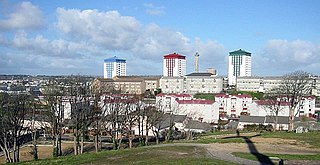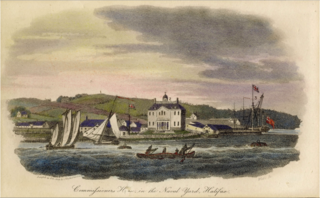
Devonport, formerly named Plymouth Dock or just Dock, is a district of Plymouth in the English county of Devon, although it was, at one time, the more important settlement. It became a county borough in 1889. Devonport was originally one of the "Three Towns" ; these merged in 1914 to form what would become in 1928 the City of Plymouth. It is represented in the Parliament of the United Kingdom as part of the Plymouth Sutton and Devonport constituency. Its elected Member of Parliament (MP) is Luke Pollard, who is a member of the Labour and Co-operative Party. The population of the ward at the 2011 census was 14,788.

The North America and West Indies Station was a formation or command of the United Kingdom's Royal Navy stationed in North American waters from 1745 to 1956, with main bases at the Imperial fortresses of Bermuda and Halifax, Nova Scotia. The North American Station absorbed the separate Newfoundland Station in 1825, and the Jamaica Station in 1830, to form the North America and West Indies Station. It was briefly abolished in 1907 before being restored in 1915. It was renamed the America and West Indies Station in 1926, absorbing what had been the South East Coast of America Station and the Pacific Station. It was commanded by Commanders-in-Chief whose titles changed with the changing of the formation's name, eventually by the Commander-in-Chief, America and West Indies Station.

Royal Navy Dockyards were state-owned harbour facilities where ships of the Royal Navy were built, based, repaired and refitted. Until the mid-19th century the Royal Dockyards were the largest industrial complexes in Britain.

Canadian Forces Base (CFB) Halifax is Canada's east coast naval base and home port to the Royal Canadian Navy Atlantic fleet, known as Canadian Fleet Atlantic (CANFLTLANT), that forms part of the formation Maritime Forces Atlantic (MARLANT).
Admiralty House may refer to:

HMD Bermuda was the principal base of the Royal Navy in the Western Atlantic between American independence and the Cold War. The Imperial fortress colony of Bermuda had occupied a useful position astride the homeward leg taken by many European vessels from the New World since before its settlement by England in 1609. French privateers may have used the islands as a staging place for operations against Spanish galleons in the 16th century. Bermudian privateers certainly played a role in many English and British wars following settlement, with its utility as a base for his privateers leading to the Earl of Warwick, the namesake of Warwick Parish, becoming the most important investor of the Somers Isles Company. Despite this, it was not until the loss of bases on most of the North American Atlantic seaboard threatened Britain's supremacy in the Western Atlantic that the island assumed great importance as a naval base. In 1818 the Royal Naval Dockyard, Bermuda officially replaced the Royal Naval Dockyard, Halifax, as the British headquarters for the North America Station (which would become the North America and West Indies Station after absorbing the Jamaica Station in 1830.

Royal Naval Dockyard, Halifax was a Royal Navy base in Halifax, Nova Scotia. Established in 1759, the Halifax Yard served as the headquarters for the Royal Navy's North American Station for sixty years, starting with the Seven Years' War. The Royal Navy continued to operate the station until it was closed in 1905. The station was sold to Canada in 1907 becoming His Majesty's Canadian Dockyard, a function it still serves today as part of CFB Halifax.

His Majesty's Naval Base, Devonport is one of three operating bases in the United Kingdom for the Royal Navy and is the sole nuclear repair and refuelling facility for the Royal Navy. The largest naval base in Western Europe, HMNB Devonport is located in Devonport, in the west of the city of Plymouth, England.

The Naval Museum of Halifax is a Canadian Forces museum located at CFB Halifax in the former official residence of the Commander-in-Chief of the North America Station (1819–1905). Also known as Admiralty House, the residence is a National Historic Site of Canada located in Halifax, Nova Scotia, Canada. The museum collects, preserves and displays the artifacts and history of the Royal Canadian Navy.
Edward Holl was an architect to the Navy Board, then later Surveyor of Buildings to the Board of Admiralty of the Royal Navy. His father is presumed to be Edward Holl, a stonemason from Beccles in Suffolk, who died in January 1816.

Prospect Camp, also referred to as Prospect Garrison, was the main infantry camp of the Bermuda Garrison, the military force stationed in the Imperial fortress of Bermuda. It also contained Fort Prospect, Fort Langton, and Fort Hamilton, as well as being the base for mobile artillery batteries, manned by the Royal Artillery. Outlying parts of the camp were disposed of in the early decades of the Twentieth Century as the garrison in Bermuda was reduced. The core area, including the barracks, passed to the local government when the garrison was withdrawn in 1957.

The Western Redoubt, or Fort William, is a square fort built on a crest on the eastern side of Government Hill, and within the boundaries of the original main British Army camp in the Imperial fortress colony of Bermuda, St. George's Garrison.

Admiralty House, Bermuda, was the official residence and offices for the senior officer of the Royal Navy in the Imperial fortress colony of Bermuda, originally the Commander-in-Chief of the North America and West Indies Station.

The Glorious Revolution of 1688 rearranged the political map of Europe, and led to a series of wars with France that lasted well over a century. This was the classic age of sail; while the ships themselves evolved in only minor ways, technique and tactics were honed to a high degree, and the battles of the Napoleonic Wars entailed feats that would have been impossible for the fleets of the 17th century. Because of parliamentary opposition, James II fled the country. The landing of William III and the Glorious Revolution itself was a gigantic effort involving 100 warships and 400 transports carrying 11,000 infantry and 4,000 horses. It was not opposed by the English or Scottish fleets.

The Department of the Director of Dockyards, also known as the Dockyard Branch and later as the Dockyards and Fleet Maintenance Department, was the British Admiralty department responsible from 1872 to 1964 for civil administration of dockyards, the building of ships, the maintenance and repair of ships at dockyards and factories, and the supervision of all civil dockyard personnel.

The Navy Office was the government office responsible for the civil administration of the British Royal Navy from 1576 to 1832. It contained all the members of the Navy Board and various other departments and offices. The day-to-day business of the Navy Office was headed by the Clerk of the Acts from 1660 until 1796. When this position was abolished duties were assumed by separate committees for Accounts, Correspondence, Stores, Transports and Victualling presided over by the Comptroller of the Navy. The Navy Office was one of two government offices that were jointly responsible for directing naval affairs. In 1832 following reforms of the naval service the Navy Office was abolished and its functions and staff taken over by the Admiralty.
Jamaica Dockyard also known as Port Royal Dockyard was a British Royal Navy Dockyard located at Port Royal, Jamaica. It was established 1675 and closed in 1905. The dockyard was initially administered by the Navy Board then later the Board of Admiralty.

St. George's Garrison was the first permanent military camp of the Bermuda Garrison established in the British colony and Imperial fortress of Bermuda, with construction of Old Military Road and the original Royal Barracks commencing during the war between Britain and France that followed the French Revolution. It would remain in use until 1957, when it was transferred to the civil (colonial) government with most of the other Admiralty and War Office properties in Bermuda.

Lord Salisbury described Malta, Gibraltar, Bermuda, and Halifax as Imperial fortresses at the 1887 Colonial Conference, though by that point they had been so designated for decades. Later historians have also given the title "imperial fortress" to St. Helena and Mauritius, despite their lacking naval dockyards and not serving as home bases for station naval squadrons.





















